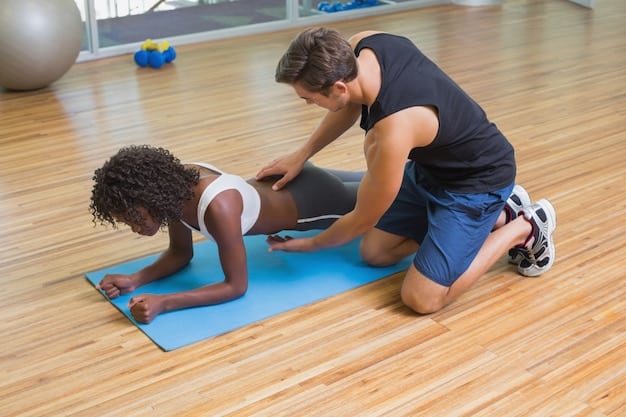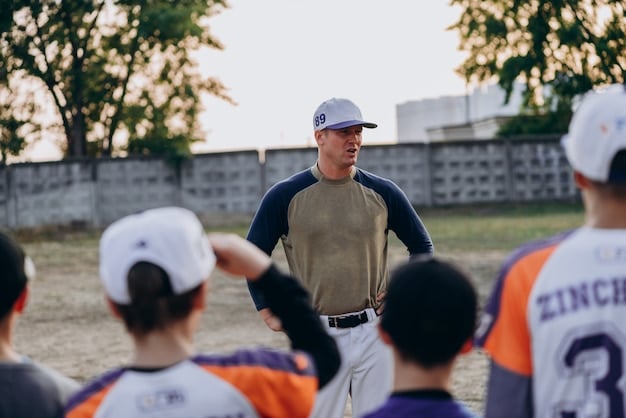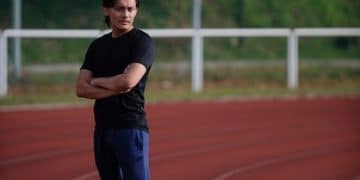Preventing Youth Sports Injuries: Safe Training Guide for Parents & Coaches

Preventing injuries in youth sports involves implementing safe training practices, including proper warm-up routines, age-appropriate conditioning, and ensuring qualified supervision to protect young athletes.
Youth sports offer incredible opportunities for kids to develop physically, mentally, and socially. However, the risk of injuries is a significant concern. Understanding and implementing strategies for preventing injuries in youth sports: a guide to safe training practices is crucial for ensuring young athletes can enjoy the benefits of sports while minimizing potential harm.
Understanding the Scope of Youth Sports Injuries
Youth sports injuries are a widespread issue affecting millions of young athletes each year. It’s important to understand the types of injuries that are most common and the factors that contribute to their occurrence. By gaining this knowledge, coaches, parents, and athletes can work together to implement effective prevention strategies and make informed decisions about training and competition.
Common Types of Injuries
Several types of injuries are particularly prevalent in youth sports. These include sprains and strains, fractures, growth plate injuries, and overuse injuries. Each type has unique characteristics and risk factors, which makes targeted prevention efforts essential.
- Sprains and Strains: These injuries involve the stretching or tearing of ligaments (sprains) or muscles/tendons (strains). They often occur due to sudden movements, falls, or collisions.
- Fractures: Broken bones are common in contact sports and activities involving high impact. Young athletes are particularly vulnerable due to their bones still developing.
- Growth Plate Injuries: Growth plates are areas of cartilage near the ends of long bones that allow bones to grow. These areas are weaker than mature bone and are susceptible to injury from acute trauma or overuse.

Factors Contributing to Injuries
Several factors can increase the risk of injuries in youth sports. These include inadequate conditioning, improper technique, overuse, and insufficient rest. Addressing these factors is vital for creating a safer environment for young athletes.
- Inadequate Conditioning: Poor physical fitness and lack of preparation can make athletes more susceptible to injuries.
- Improper Technique: Incorrect form during training or competition can place excessive stress on certain body parts.
- Overuse: Participating in high-intensity activities without adequate rest and recovery can lead to overuse injuries, such as stress fractures and tendonitis.
- Insufficient Rest: Young athletes need adequate sleep and recovery time to allow their bodies to repair and rebuild.
Understanding the common types of injuries and the factors that contribute to their occurrence is the first step in preventing youth sports injuries. By addressing these issues, coaches, parents, and athletes can create a safer and more enjoyable environment for young athletes.
The Importance of Proper Warm-Up and Cool-Down Routines
Warming up and cooling down are crucial components of any athletic activity, particularly in youth sports. These routines prepare the body for exercise, reduce the risk of injury, and promote recovery. Ignoring these routines can significantly increase the likelihood of strains, sprains, and other musculoskeletal problems.
Key Elements of an Effective Warm-Up
A proper warm-up should gradually increase the heart rate, body temperature, and blood flow to the muscles. It should also include dynamic stretching exercises that improve range of motion and flexibility. A well-designed warm-up can enhance performance and reduce the risk of injury.
- Cardiovascular Exercise: Begin with light cardio activities, such as jogging or jumping jacks, to increase heart rate and blood flow.
- Dynamic Stretching: Incorporate dynamic stretches that mimic the movements of the sport, such as arm circles, leg swings, and torso twists.
- Sport-Specific Drills: Include drills that are specific to the sport, such as passing, shooting, or agility exercises.
Benefits of an Effective Cool-Down
A proper cool-down helps to gradually decrease the heart rate and body temperature, prevent muscle soreness, and promote recovery. It should include light cardio and static stretching exercises that target the muscles used during the activity. A good cool-down can help prevent stiffness and improve flexibility.
- Light Cardiovascular Exercise: Continue with light cardio activities, such as walking or jogging, to gradually decrease the heart rate.
- Static Stretching: Perform static stretches, holding each stretch for 20-30 seconds, to improve flexibility and reduce muscle soreness.
- Foam Rolling: Use a foam roller to massage and release tension in the muscles.
Incorporating proper warm-up and cool-down routines into youth sports training can significantly reduce the risk of injuries and promote overall athletic performance. These routines are essential for preparing the body for exercise and facilitating recovery afterward.
Age-Appropriate Training and Conditioning
Training and conditioning programs for youth sports should be tailored to the age and developmental stage of the athletes. What works for a high school athlete may not be appropriate or safe for a younger child. Age-appropriate training programs should consider the physical and cognitive development of the athletes, as well as the specific demands of the sport.
Developmental Considerations
Young athletes are still growing and developing, which means their bodies are more vulnerable to certain types of injuries. Training programs should be designed to accommodate these developmental considerations and avoid placing excessive stress on growing bones and joints. Focus on fundamental movement skills and progressive conditioning.
Training programs should be designed to accommodate these developmental considerations and avoid placing excessive stress on growing bones and joints. Focus on fundamental movement skills and progressive conditioning.
Types of Age-Appropriate Exercises
Age-appropriate exercises focus on building a solid foundation of strength, flexibility, and coordination. These types of exercises will help prepare athletes for more advanced training as they get older. Focus on body-weight exercises, agility drills, and balance training.
- Body-Weight Exercises: Push-ups, squats, and lunges are great body-weight exercises that can help build strength and endurance.
- Agility Drills: Cone drills, ladder drills, and shuttle runs can help improve agility and coordination.
- Balance Training: Balance boards and wobble boards can help improve balance and stability.
The Role of Qualified Coaches and Supervision
Qualified coaches play a critical role in preventing injuries in youth sports. They are responsible for designing and implementing safe training programs, teaching proper technique, and providing proper supervision during practices and games. Qualified coaches also prioritize athlete safety and well-being above all else.
Qualities of a Qualified Coach
A qualified coach should possess the knowledge, skills, and experience necessary to train young athletes safely and effectively. A qualified coach knows the proper techniques, how to provide feedback and how to respond to injuries and other health concerns.
A qualified coach should possess the knowledge, skills, and experience necessary to train young athletes safely and effectively. A qualified coach knows the proper techniques, how to provide feedback and how to respond to injuries and other health concerns.
- Knowledge of Safety Protocols: A qualified coach should be knowledgeable about safety protocols and emergency procedures.
- Effective Communication Skills: Effective communication skills are necessary for providing clear instructions and feedback to athletes.

The Importance of Proper Supervision
Supervision is a must in preventing injuries in youth sports. Coaches should closely monitor athletes during practices and games to ensure they are following safety protocols and using proper technique. Supervision includes how to monitor for signs of fatigue, pain, or risky behavior.
- Monitoring Athletes: Coaches should closely monitor athletes for signs of fatigue, pain, or risky behavior.
- Enforcing Safety Rules: Safety rules should be enforced consistently to prevent injuries and promote a safe environment.
Nutrition, Hydration, and Rest: Essential for Injury Prevention
Proper nutrition, hydration, and rest are essential components of injury prevention in youth sports. These factors play a critical role in supporting athletic performance, promoting recovery, and reducing the risk of injuries. Ignoring these elements can lead to fatigue, dehydration, and increased susceptibility to musculoskeletal problems.
The Importance of Proper Nutrition
A balanced diet provides young athletes with the energy and nutrients they need to perform at their best and recover quickly after exercise. Proper nutrition supports muscle growth and repair, strengthens bones, and boosts the immune system. Focus on nutrient-dense foods and avoid processed foods and sugary drinks.
Focus on nutrient-dense foods and avoid processed foods and sugary drinks.
- Carbohydrates: Carbohydrates are the primary source of energy for athletes. Choose complex carbohydrates, such as whole grains, fruits, and vegetables.
- Protein: Protein is essential for muscle growth and repair. Include lean protein sources, such as chicken, fish, beans, and tofu.
- Healthy Fats: Healthy fats are important for hormone production and overall health. Include sources of healthy fats, such as avocado, nuts, and olive oil.
Staying Hydrated
Dehydration can cause fatigue, muscle cramps, and decreased performance, increasing the risk of injuries. Young athletes should drink plenty of fluids before, during, and after exercise. Water is the best choice for hydration, but sports drinks can be helpful during prolonged or intense activity.
- Monitor Urine Color: Clear or pale yellow urine is a sign of adequate hydration.
- Drink Regularly: Encourage athletes to drink regularly throughout the day, even when they are not thirsty.
Recognizing and Managing Injuries Effectively
Prompt recognition and effective management of injuries are crucial for preventing long-term complications and ensuring a safe return to sports. Coaches, parents, and athletes should be able to recognize the signs and symptoms of common injuries and know how to respond appropriately. This includes knowing when to seek medical attention and how to properly manage injuries at home.
Recognizing Common Injury Symptoms
Not all injuries are immediately obvious, so it’s important to be aware of the subtle signs and symptoms that might indicate a problem. Common signs include pain, swelling, bruising, and limited range of motion. However, some injuries may present with more subtle symptoms, such as stiffness, tenderness, or a feeling of instability.
Steps for Managing Injuries
When an injury occurs, it’s important to take immediate action to minimize further damage and promote healing. Whether it’s a sprain, strain, or contusion, implementing these steps will help keep the injury from becoming more severe.
- Rest: Protect the injured area by avoiding activities that cause pain or discomfort.
- Ice: Apply ice to the injured area for 15-20 minutes at a time, several times a day.
- Compression: Wrap the injured area with a compression bandage to help reduce swelling.
| Key Point | Brief Description |
|---|---|
| 💪 Proper Warm-up | Prepares the body for exercise and reduces injury risk. |
| 🍎 Nutrition & Hydration | Supports performance and recovery, minimizing injury risk. |
| 🤕 Injury Management | Recognize and manage injuries effectively to prevent complications. |
| 🧑🏫 Qualified Coaches | Provide safe training, proper technique, and supervision. |
Frequently Asked Questions
▼
Warming up prepares the body for physical activity by increasing blood flow to muscles and improving flexibility, which reduces the risk of strains and sprains.
▼
Signs of overtraining include fatigue, decreased performance, increased irritability, loss of appetite, and frequent injuries. Ensure adequate rest and recovery.
▼
Coaches can ensure safety by checking equipment, teaching proper techniques, enforcing rules, and monitoring athletes for signs of fatigue or injury.
▼
Proper nutrition provides energy, supports muscle and bone health, and aids recovery, reducing the risk of injuries and improving overall athletic performance.
▼
An athlete should see a doctor for severe pain, swelling, inability to bear weight, or any injury that doesn’t improve with initial first aid.
Conclusion
Preventing injuries in youth sports: a guide to safe training practices goes beyond just physical preparation; it encompasses a holistic approach involving education, proper supervision, and a commitment to the well-being of young athletes. By implementing the strategies outlined in this guide, parents, coaches, and athletes can work together to minimize the risk of injuries and ensure that youth sports remain a positive and rewarding experience for all.





